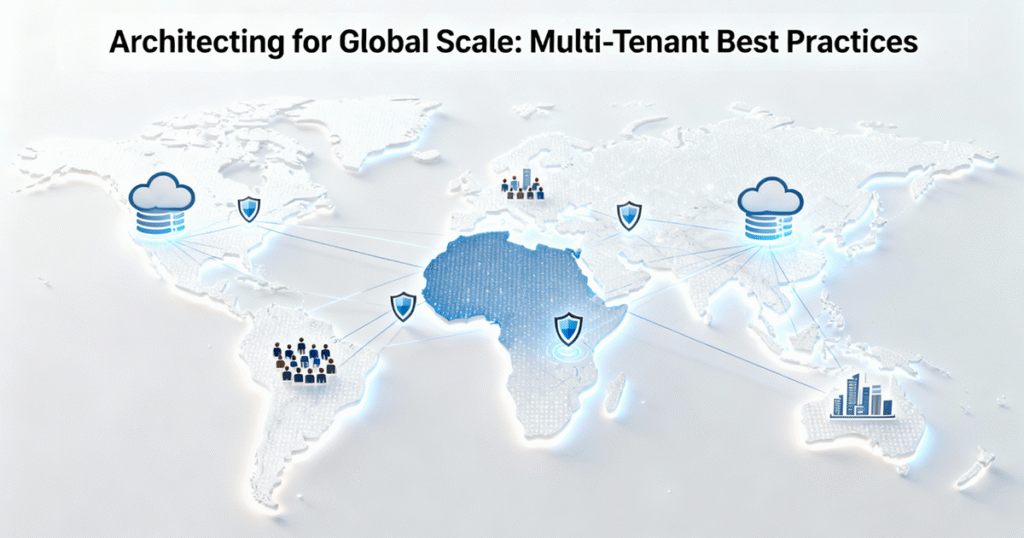In our increasingly digital world, enterprises want services that not only work well locally but scale reliably across regions, customers, and usage patterns. For SaaS, GenAI platforms, or any cloud-native system aiming for global reach, multi-tenant architecture is essential. It enables efficient resource usage, operational simplicity, and consistent experiences across customers (tenants) without duplicating infrastructure.
At Brigita, we help businesses design Scalable SaaS Architectures that adapt to enterprise growth, regulatory needs, and global expansion. In this blog, we’ll explore best practices for Enterprise Multi-Tenancy and Cloud-Native SaaS Design that ensure systems can scale to serve global users seamlessly.
What is Multi-Tenancy?

Multi-tenancy means having multiple customers (tenants) share a single software instance (or shared infrastructure), while keeping tenant data, configurations, and performance isolated.When operating at a global scale, challenges like latency, regional compliance (e.g., PR – Data privacy regulations ), and cost optimization become critical.
Key Trends in Scalable SaaS Architecture
Cloud-Native SaaS Design – Containerization, serverless computing, and managed cloud services.
Global Edge Deployments – CDNs and caching to reduce latency.
Regulatory Compliance – Increasing importance of data residency and privacy laws.
Deep Observability – Tenant-level and region-level monitoring for SLA compliance.
Incremental Delivery – Feature flags and safe rollouts.
Best Practices for Enterprise Multi-Tenancy at Global Scale
Tenant Isolation & Security
Implement logical or physical isolation depending on tenant needs.
Apply role-based access controls, encryption, and tenant-scoped APIs.
Regular audits to prevent data leakage across tenants.
Global Deployment & Data Residency
Deploy services in multiple regions/availability zones.
Use CDNs and edge caching to reduce latency.
Ensure compliance with data residency laws, like GDPR or HIPAA.
Elasticity & Scalability
Design horizontally scalable services for cloud-native SaaS design.
Implement auto-scaling policies to handle unpredictable workloads.
Use multi-region load balancing for high availability.
Resilience & Fault Tolerance
Adopt disaster recovery plans and regional redundancy.
Implement circuit breakers and retries for fault tolerance.
Balance strong vs. eventual consistency based on workload.
Monitoring & Observability
Track per-tenant performance metrics across regions.
Use centralized logging and tracing for debugging.
Define clear SLAs with automated alerts and reporting.
Note: SLAs typically refer to Service-Level Agreements, which are contracts defining the level of service a provider delivers to a customer, including service quality, availability, and response times, with specific penalties for failing to meet the agreed standards.
Performance Optimization
Cache frequently accessed data at regional edges.
Optimize queries and avoid cross-region traffic where possible.
Implement asynchronous workflows for heavy operations.
Cost Optimization
Track costs per tenant and region, Use cloud provider cost tools
Avoid over-isolating tenants when shared infrastructure is sufficient.
Deployment & Continuous Delivery
Roll out features with feature flags to minimize risk. A feature flag (also called a feature toggle or switch) is a configurable switch in our code that lets us turn a feature on or off without deploying new code. It’s usually controlled by a config file, database setting, or a feature flag service.
Canary or blue/green deployments
Blue = current production version (active, serving traffic), Green = new version (staged, ready for release). We deploy our new release to the Green environment (while Blue keeps serving users). After testing and validating Green, we switch traffic from Blue → Green (via load balancer/DNS change). If issues are found, we can roll back instantly by routing traffic back to Blue.
Manage backward-compatible schema changes
A backward-compatible schema change is a database schema update that doesn’t break existing application code still running on the old version. Roll out features with feature flags to minimize risk.
Common Challenges & How to Mitigate Them
Challenge | Solution |
Latency vs. Consistency | Use eventual consistency for non-critical data; caching for responsiveness. |
Regulatory Complexity | Adopt region-specific data residency strategies. |
Operational Overhead | Automate tenant onboarding & CI/CD pipelines. |
Security Risks | Regular audits, IAM best practices, strong tenant isolation. |
Cost Overruns | Per-tenant cost tracking, resource rightsizing, and avoid over-isolation. |
Brigita’s Approach: From Vision to Implementation
At Brigita, we help enterprises build Scalable SaaS Architecture using proven frameworks:
Strategic Discovery – Compliance and region analysis.
Cloud-Native SaaS Design – Kubernetes, serverless, CI/CD.
Enterprise Multi-Tenancy Security – Isolation, encryption, compliance.
Performance Engineering – CDN integration, observability, failover.
Automation – Tenant onboarding and lifecycle automation.
Cost Efficiency – Continuous optimization across tenants and regions.
FAQs
Q1. What’s the best tenant isolation model?
Shared schema works for cost efficiency; separate databases/schemas suit regulated industries or sensitive workloads.
Q2. How can I ensure low latency worldwide?
Deploy in multiple regions, use edge caching, and optimize API calls to reduce chattiness.
Q3. Is strong consistency always necessary?
Not always. Strong consistency for critical data; eventual consistency for logs, analytics, or background jobs.
Final Thoughts
Multi-Tenant Architecture is the backbone of modern Scalable SaaS Architecture. At global scale, the right design balances performance, compliance, cost, and resilience.
Brigita helps enterprises adopt Enterprise Multi-Tenancy and Cloud-Native SaaS Design to deliver secure, scalable, and compliant experiences to customers worldwide.
Ready to scale your SaaS globally? Let Brigita architect your multi-tenant future.
Search
Categories

Author
-
Devirani M is a backend developer with over 10 years of experience in PHP and frameworks like Laravel, CakePHP, and Zend. She has a strong passion for learning emerging technologies and applying AI tools such as ChatGPT for problem-solving. She enjoys finding simple solutions to complex challenges and exploring new ways to improve development. Beyond coding, she enjoys reading books and listening to music.
